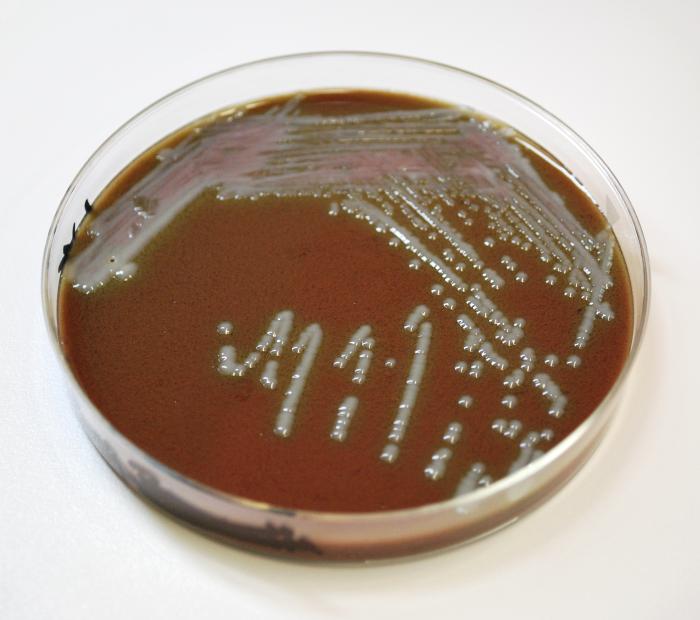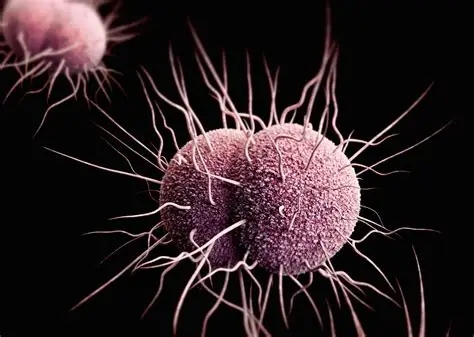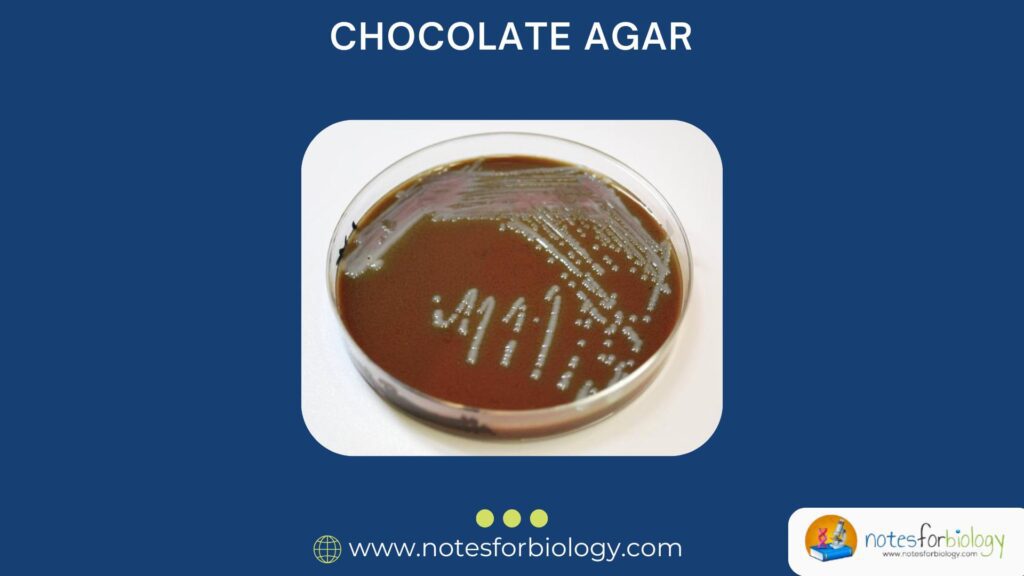Introduction
Chocolate agar is a non-selective, enriched growth medium primarily used to grow bacteria that require special nutrients. In the field of microbiology, growth media play a vital role in helping scientists grow and study bacteria. One such specialized medium is Chocolate Agar—a name that often surprises people because it has nothing to do with the sweet treat! Instead, its name comes from its chocolate-brown color, which results from a specific preparation process. Chocolate agar is an enriched medium that supports the growth of fastidious (picky) organisms—especially those bacteria that don’t grow well on ordinary nutrient agar.
Let’s explore the world of chocolate agar in detail—from what it contains, how it works, how it is made, what results it gives, and why it is so important in clinical microbiology.
Table of Contents
What is Chocolate Agar?
Chocolate agar is a non-selective, enriched growth medium primarily used to grow bacteria that require special nutrients. These bacteria are known as fastidious organisms, and they often do not grow on regular agar media.

The key feature of it is that red blood cells are lysed (broken open) by heat during preparation, which releases essential growth factors that many organisms require.
The “chocolate” in its name refers to the color, not the flavor or contents!
Composition of Chocolate Agar
It is based on blood agar, but it is treated with heat to break down red blood cells. Here is what it typically contains:
1. Nutrient Base (Peptone or Infusion Base)
- Provides amino acids, nitrogen, vitamins, and minerals.
- Commonly used: Beef heart infusion, tryptone, or peptone.
2. Agar
- A gelling agent extracted from red algae.
- Provides the solid surface for bacterial growth.
3. Hemoglobin or Whole Blood (usually sheep or horse)
- Provides X factor (hemin)—essential for the growth of some bacteria.
- Heated to lyse the cells, giving the medium its chocolate-brown color.
4. NAD (Nicotinamide Adenine Dinucleotide)
Also called V factor, necessary for bacteria like Haemophilus influenzae.
5. Distilled Water
Solvent for all components.
Optional Additives:
Depending on the application, other substances may be added:
- IsoVitaleX or Vitox supplement: Contains vitamins and amino acids.
- Antibiotics (for selective chocolate agar like Thayer-Martin): Suppress unwanted bacteria or fungi.
- Example: Vancomycin, Nystatin, Colistin.
Principle of Chocolate Agar
The principle of chocolate agar lies in providing special nutrients that fastidious organisms need to grow—particularly X factor (hemin) and V factor (NAD).
Why heat the blood?
- Lysing red blood cells by heating them at around 75°C releases:
- Hemoglobin → which provides hemin (X factor).
- NAD (V factor) from within red cells or from leukocytes.
- Heating also inactivates enzymes that would otherwise destroy NAD.
- This makes the agar capable of supporting bacteria like:
- Haemophilus influenzae
- Neisseria gonorrhoeae
- Neisseria meningitidis
How to Prepare Chocolate Agar (Step-by-Step)
1. Ingredients (for 1 liter of medium):
- Peptone: 10 g
- Sodium chloride (NaCl): 5 g
- Agar: 15 g
- Distilled water: 1000 mL
- Sheep or horse blood: 5–10% (50–100 mL)
- Optional: Supplements (IsoVitaleX), antibiotics if needed
2. Procedure:
A. Prepare the base medium
- Dissolve peptone, NaCl, and agar in 1L of distilled water.
- Heat gently while stirring to dissolve the agar.
- Sterilize by autoclaving at 121°C for 15 minutes.
B. Cool the base
- Let the sterilized base medium cool to about 50°C. This prevents protein denaturation in the blood.
C. Add blood
- Add sterile defibrinated sheep or horse blood (5–10%) slowly while stirring.
- Warm the mixture to 75°C to lyse the red blood cells.
- The medium turns a brown, chocolate-like color.
- Do not boil—overheating destroys nutrients.
D. Pour the plates
- Pour the prepared medium into sterile Petri dishes (15–20 mL per plate).
- Let them solidify and store in refrigerator (2–8°C) until use.
Colony Appearance and Results
Colony Morphology
- Colonies on chocolate agar vary depending on the organism.
- Haemophilus influenzae: Small, grey, moist colonies.
- Neisseria gonorrhoeae: Transparent, convex colonies.
- Neisseria meningitidis: Larger, bluish-grey colonies.
Hemolysis
- No hemolysis zones are observed as red cells are already lysed.
- Unlike blood agar, hemolytic activity cannot be assessed here.
Uses of Chocolate Agar
Chocolate agar has many important uses, especially in the diagnosis of infections caused by fastidious bacteria.
1. Isolation of Fastidious Bacteria
- Most important use.
- Grows organisms that do not grow on nutrient or blood agar.
Examples:
- Haemophilus influenzae
- Haemophilus ducreyi
- Neisseria gonorrhoeae
- Neisseria meningitidis
- Brucella species (with supplements)
- Moraxella catarrhalis
2. Diagnosis of Meningitis

Used for culturing cerebrospinal fluid (CSF) in suspected bacterial meningitis.
3. Diagnosis of Gonorrhea

- Neisseria gonorrhoeae is best isolated on chocolate agar.
- Often used with selective supplements (Thayer-Martin or Martin-Lewis agar).
4. Culturing Sterile Site Fluids
Blood, CSF, pleural fluid, joint fluid—where fastidious bacteria may be present.
5. Research and Laboratory Testing
To study bacterial growth characteristics, drug sensitivity, or nutritional requirements.
Selective Chocolate Agar
Chocolate agar can be made selective by adding antibiotics to suppress normal flora.
Advantages of Chocolate Agar
- Grows fastidious organisms that don’t grow elsewhere.
- Good for critical infections like meningitis and gonorrhea.
- Can be made selective for specific clinical use.
- Easy to prepare with basic laboratory setup.
Limitations
- Not suitable for observing hemolysis.
- Overheating during preparation can destroy essential nutrients.
- Contamination risk if not prepared and stored properly.
- May support growth of non-pathogens if not made selective.
Storage and Shelf Life
- Store at 2–8°C, away from light and drying.
- Should be used within 1–2 weeks for best results.
- Avoid repeated warming and cooling, which affects quality.
Precautions During Use
- Use aseptic technique to prevent contamination.
- Always compare with control strains for proper identification.
- Check for cracks, dehydration, or contamination before use.
Real-life Clinical Relevance
Case 1: Suspected Meningitis
- A patient with fever, neck stiffness, and headache undergoes CSF collection.
- CSF is cultured on chocolate agar.
- Neisseria meningitidis grows—lifesaving identification.
Case 2: STD Diagnosis
- Woman presents with genital discharge.
- Vaginal swab cultured on Thayer-Martin (selective chocolate agar).
- Neisseria gonorrhoeae identified—correct antibiotics given.
Conclusion
Chocolate agar is a powerful tool in the world of microbiology, especially in clinical diagnostics. Though it may sound like a dessert, its real purpose is far more important—it helps identify life-threatening infections by supporting the growth of delicate, fastidious organisms. With its enriched formula and versatility, it stands as a crucial medium in the fight against infectious diseases.
By understanding its composition, principle, preparation, uses, and limitations, laboratory professionals and students can appreciate the significant role chocolate agar plays in detecting and managing diseases that would otherwise be hard to diagnose.
FREQUENCY ASKED QUESTIONS
What is Chocolate Agar?
Chocolate agar is a non-selective, enriched culture medium used to grow fastidious bacteria that require special nutrients, such as Haemophilus influenzae and Neisseria species. It is made by heating blood agar, which lyses red blood cells and releases nutrients like NAD (V factor) and hemin (X factor).
Why is it called “Chocolate” Agar?
It’s called “chocolate” agar because of its brown color, which results from heating red blood cells. It does not contain chocolate or cocoa.
What is the principle behind chocolate agar?
The principle is to provide essential nutrients—especially X factor and V factor—by lysing red blood cells, which allows the growth of bacteria that cannot grow on regular agar or even blood agar.
Related Articles




